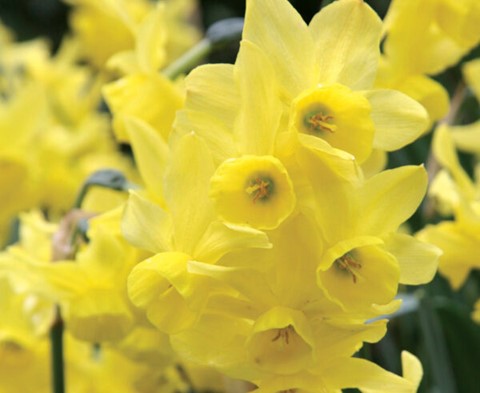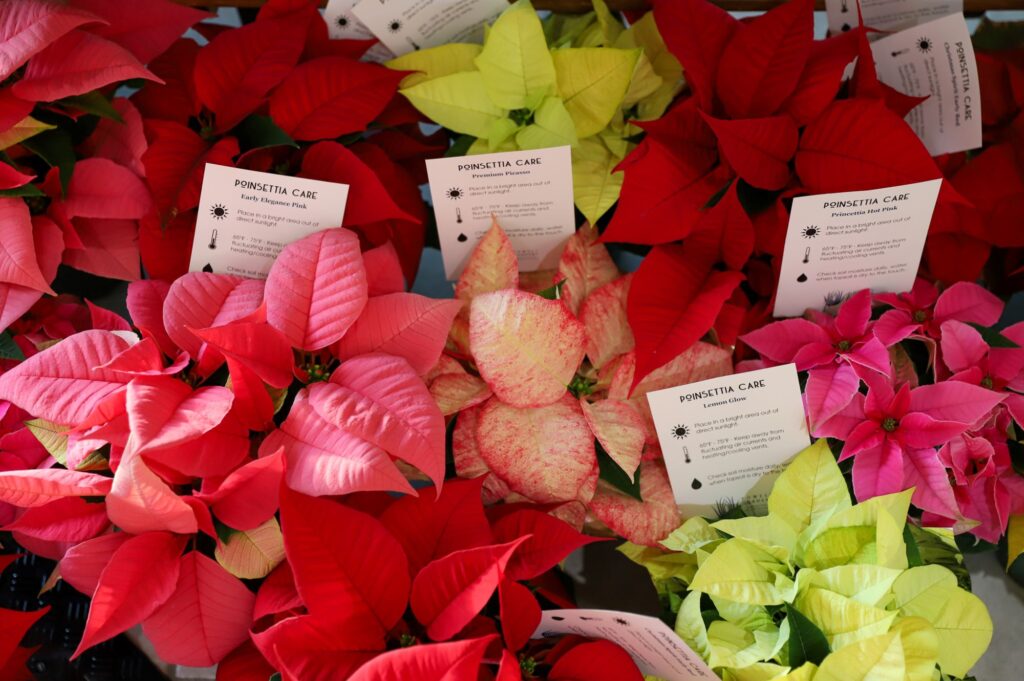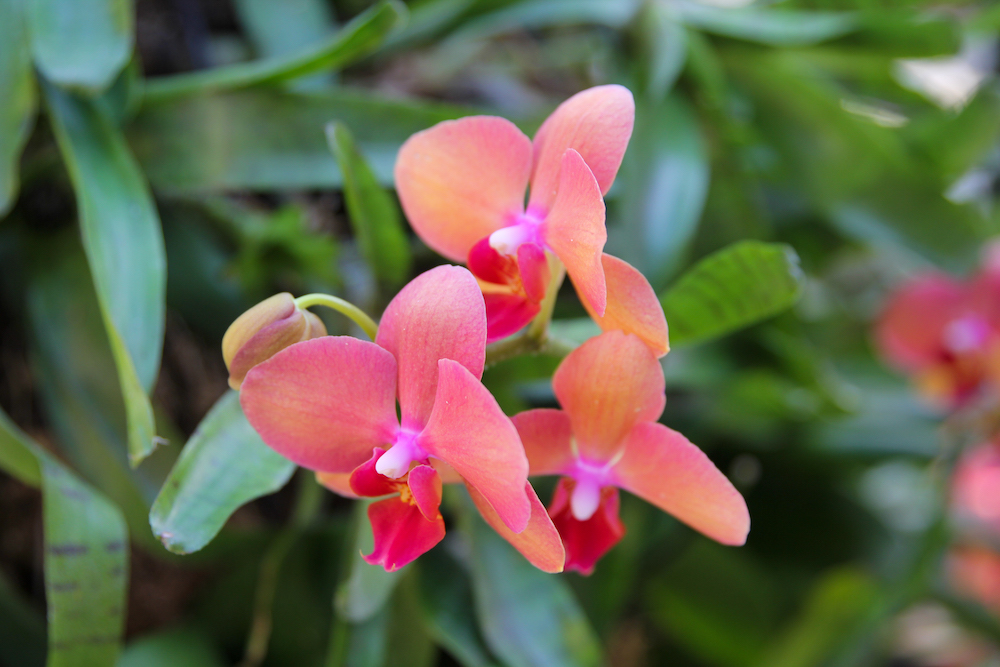
Poinsettias (Euphorbia pulcherrima) are often associated with the holiday season. Native to Mexico, the vibrant blooms of this plant come from modified leaves called “bracts.” The bracts change color in response to decreased sunlight, which makes them the most colorful as the days get shorter in the winter months. There are so many varieties, everyone is sure to find a color they like! At Powell Gardens, favorites include Viking Cinnamon (a rose gold color), Princettia Hot Pink (a splashy pink color), and Lemon Glow (a vivid yellow color).
Growing Poinsettias at Powell Gardens
Around 1,500 poinsettias are grown in Powell Gardens’ greenhouses each year, using more than 3,000 rooted cuttings. The team in charge of these plants begin working a whole year in advance to have the poinsettias ready for display and purchase by visitors during the Evergy Festival of Lights! Dakota Lepker (Senior Gardener, Production) has been working in the production side of horticulture at Powell Gardens since May of 2023.
“Production is a really interesting side of any botanical garden,” says Lepker. “Our team supports all of the displays, member plant giveaways, and plants for sale during the year. We care for and grow many of the plants you see during your visit, including all the poinsettias we’re enjoying at Festival of Lights now. This year, we’re excited to introduce new varieties like Early Elegance Pink and Christmas Mouse Pink at Powell Gardens.” To learn more about how Powell Gardens grows poinsettias, see the timeline below.
January – March
- This time of year is all about planning ahead! Powell Gardens’ staff members are selecting poinsettia varieties and working across departments to understand what plants will be needed across Powell Gardens. Orders are placed in January or early February.
April – June
- The end of spring and early summer has our staff preparing Powell Gardens’ greenhouses and equipment for poinsettia production. This includes making sure all of the greenhouse equipment is working properly (heating, cooling, shade, fans, power, and more), pots are washed, soil is ready, houses are cleaned, and the irrigation system has no kinks.
July – September
- The start to Powell Gardens’ poinsettias arrives in July. Our team makes plant cuttings, rooting plants into their new homes. Environmental factors are closely watched and adjusted. Some plants are pinched to force branching out.
October – December
- As the weather cools, the team enters the final stretch in growing Powell Gardens’ poinsettias. During this time, plants are regularly pruned as they grow. The crop is finished mid-November to December. Once the current crop is finished, it’s time to start planning for next year!
Fun Fact: How Do Greenhouses Work?
A greenhouse works by converting light energy into heat energy. As sunlight enters the greenhouse, plants absorb the sun’s rays and convert the energy into heat. This allows plants to stay warm at night.
Powell Gardens’ greenhouse complex enables staff to care for our living collection all year long. Currently, Powell Gardens’ staff is caring for approximately 14,000 plants to get ready for Kansas City’s botanical gardens’ spring season.
Tips for Caring for and Growing Poinsettias at Home
Poinsettias can thrive at home in the right conditions. Pay careful attention to light and temperature to keep your plant healthy and happy.
- Poinsettias should receive direct light. Placing them in an east or west window will ensure they receive bright light daily.
- An indoor temperature of 65-70 degrees is ideal for growing these plants. Damage may occur if poinsettias are placed in environments where the temperature fluctuates, or where the plant may become dried out or chilled from a cold draft, heat duct, poorly insulated window, fireplace, fan, or space heater. Temperatures below 50 degrees can further damage or even kill poinsettias.
- The soil for poinsettias should be kept moist. Do not allow plants to dry out or wilt! Excessive wetness or poor drainage may rot the plant’s roots.
How Can I Make my Poinsettia Bloom Again?
While poinsettias are beautiful as green plants, most would like to see their plant colorful again in every holiday season. To make this happen, light must be excluded from the plant for a period of time while maintaining plant health. The reduction in light stops the plant from forming chlorophyll, the pigment that gives the plant its green color. This changes the bracts (or “leaves”) of the plant to red, pink, or white depending on the variety.
To get your plant ready for the holidays, plan to commit to a year of preparation. While not an easy task, every home gardener with a bit of planning and determination can make their poinsettia bloom again! Use the timeline below for a beautiful bloom next holiday season.
- Early January: Fertilize the plant if you notice new growth. To keep your plant in bloom, provide adequate light and water.
- Mid-February: If your plant has become leggy (new growth with no bracts), cut back by ⅓ to ½ depending on how shrubby you want to keep the plant promoting new, more dense growth.
- Mid-March: Prune any dried parts of the plant. Add potting soil if needed. Continue keeping in a bright, sunny window.
- End of May: Trim 2-3 inches off branches to promote additional growth. Transfer to a new container if needed.
- Mid-June: Move the plant outdoors and into indirect light to adjust to the outdoor climate. (You can also plant directly into your garden if you want!)
- Early July: Trim as needed. Move into full sun. Water and fertilize.
- Early September: Move the plant indoors, keeping it in direct sunlight.
- Late September: Beginning on or around the fall equinox, give the plant 16 hours of uninterrupted darkness. Put your poinsettia in a closet, basement, or under a box to shield it from light. Alternate the 16 hours of darkness with 8 hours of bright light, rotating the plant daily to give all sides even light. Maintain a night temperature in the low 60 degrees. Continue to water and fertilize as needed. This will continue through late November—don’t give up!
- Late November: Around Thanksgiving, stop the darkness/light rotation. Put the plant in a window or area that gets at least 6 hours of direct light.
- Late December: Enjoy your vibrant, beautiful poinsettia!
Poinsettias at Powell Gardens
Our team works hard to produce the beautiful and cheerful poinsettias guests enjoy at Powell Gardens! To see them on display, check out the Visitor Center and Peppermint Warming Station during Festival of Lights. During this time of year, Powell Garden-grown poinsettias are available for sale in The Marketplace. If you’re looking for a poinsettia grown in the wild, you’ll need to travel to Central America or Mexico looking for bushes and trees of this beautiful plant.
Related Posts


